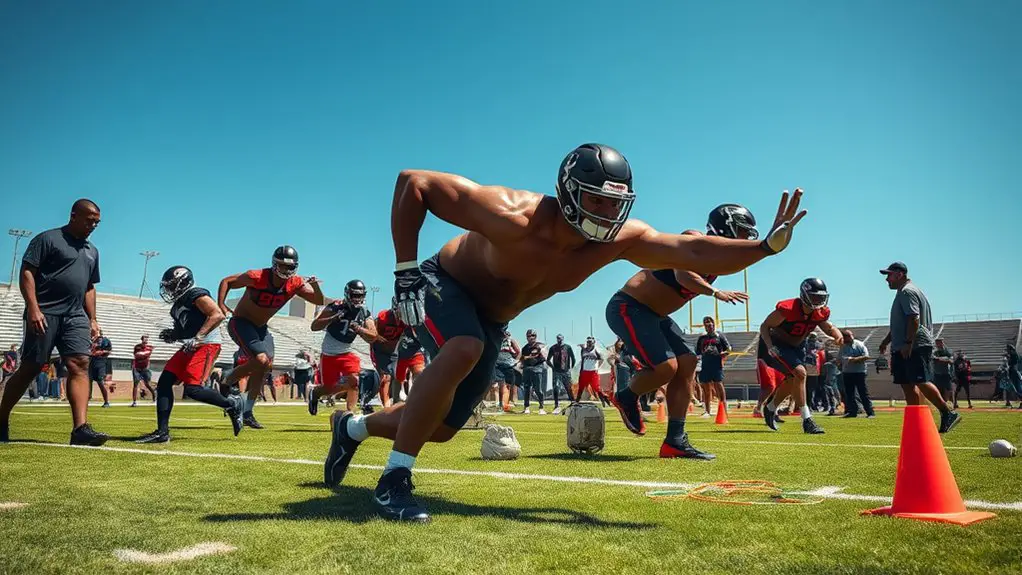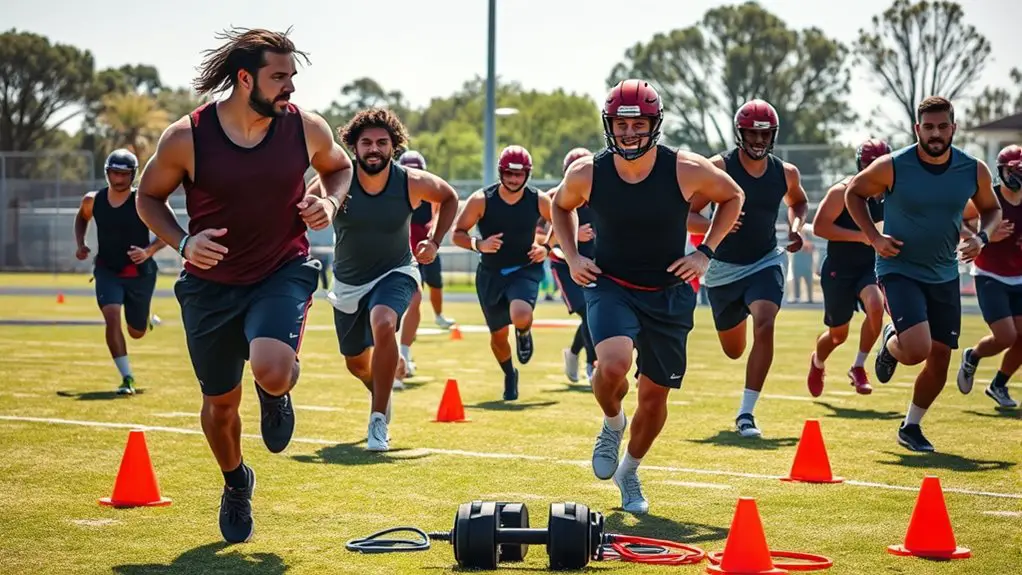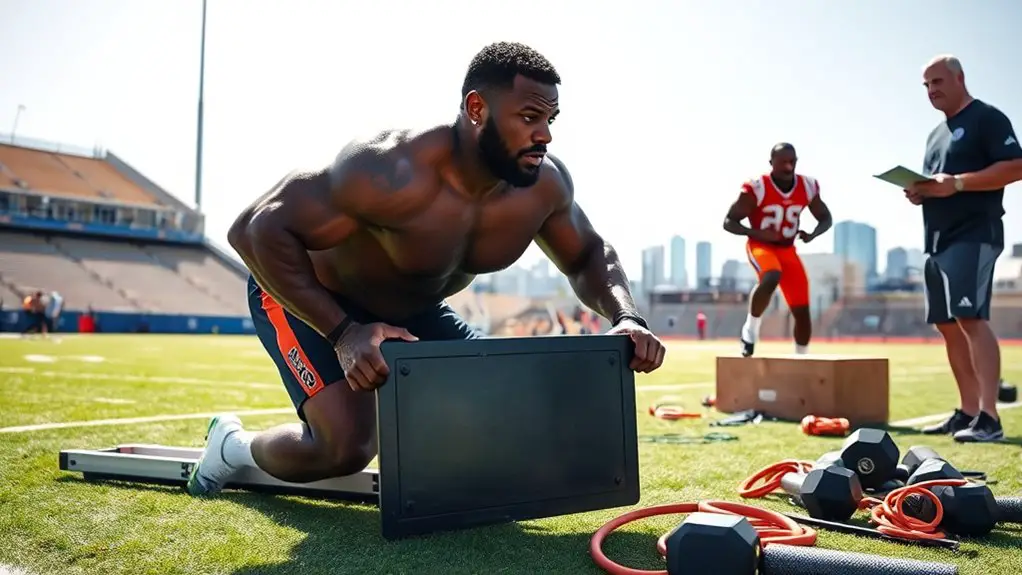How NFL Players Train in the Offseason

NFL players use the offseason to enhance their skills and physical fitness through structured training programs. You’ll find them focusing on personalized workout regimens that improve strength, speed, and agility. Nutrition plays a key role, with meal timing and macronutrient balance fueling their workouts and recovery. They incorporate recovery methods like foam rolling and cold therapy to prevent injuries. The offseason’s not just about physical training; it also involves mental conditioning and skill development. There’s so much more to explore about their training methods.
Importance of Offseason Training

Offseason training is essential for NFL players, as it lays the foundation for success during the regular season. It’s during this time that you can focus on your offseason goals, like improving strength, speed, and agility. Establishing training consistency is key; it helps you build endurance while minimizing the risk of injuries. By sticking to a structured program, you not only develop your skills but also enhance your overall physical condition.
Additionally, using proper techniques and listening to your body is vital. Ensuring you warm up and cool down effectively can prevent strains and sprains. It’s important to balance intense workouts with adequate rest and recovery. Remember, safety should always be your priority. When you approach your offseason training with a clear plan and commitment, you’re setting yourself up for a successful and safe regular season. Investing in your preparation now pays off big time later on the field.
Personalized Workout Regimens
When it comes to maximizing performance, personalized workout regimens are indispensable for NFL players. These athletes undergo thorough athlete assessments to identify their strengths, weaknesses, and injury risks. With this information, trainers can design customized fitness programs tailored to each player’s specific needs. This individualized approach not only enhances performance but also prioritizes safety, ensuring players don’t push their limits too far.
By focusing on areas like agility, endurance, and strength, these regimens help players improve while minimizing the risk of injury during the demanding season ahead. Moreover, incorporating recovery strategies into the workout plan is essential. This means balancing intense workouts with rest and rehabilitation, which is critical for long-term health.
Ultimately, a personalized workout regimen empowers players to reach their peak performance safely, setting them up for success when the season rolls around.
Strength and Conditioning Programs

While personalized workout regimens lay the foundation, strength and conditioning programs play a crucial role in an NFL player’s development. These programs are designed to enhance performance while prioritizing safety. You’ll engage in strength training to build muscle and increase power, focusing on proper form to prevent injuries. It’s important to work closely with a certified trainer who understands your unique needs and limitations.
Incorporating conditioning exercises is equally significant, as they improve endurance and agility, helping you maintain peak performance throughout the season. These sessions often include interval training, agility drills, and sport-specific movements tailored to your position.
Always listen to your body, and don’t hesitate to adjust your routine if something doesn’t feel right. By committing to a well-structured strength and conditioning program, you’ll be on the right path to achieving your goals and ensuring a safe, effective training experience.
Nutrition Plans for Peak Performance
To reach peak performance, you need to prioritize your nutrition just as much as your training. Meal timing and macronutrient balance play vital roles in fueling your body for intense workouts and recovery. Let’s explore how these strategies can elevate your game.
Meal Timing Strategies
Effective meal timing strategies are essential for NFL players seeking peak performance. By focusing on meal frequency optimization, you can guarantee your body gets the nutrients it needs when it matters most. Remember to prioritize pre workout nutrition to fuel your training sessions effectively.
Here’s a quick reference table to guide your meal timing:
| Meal Type | Timing |
|---|---|
| Pre Workout Meal | 30-60 minutes prior |
| Post Workout Meal | Within 30 minutes |
| Daily Meals | Every 3-4 hours |
| Hydration | Throughout the day |
Adhering to these strategies helps maintain energy levels, supports recovery, and minimizes injury risks. With the right timing, you’ll maximize your performance during training and game days alike.
Macronutrient Balancing Techniques
Meal timing strategies set the stage for understanding macronutrient balancing techniques, which play a pivotal role in an NFL player’s nutrition plan. To optimize performance, you’ll want to focus on appropriate macronutrient ratios and make necessary dietary adjustments. Here’s how you can effectively balance your intake:
- Prioritize lean proteins for muscle recovery
- Include healthy fats for energy and hormone regulation
- Choose complex carbohydrates for sustained energy
- Hydrate adequately to support overall performance
- Monitor portion sizes to avoid overeating
Recovery Methods and Techniques

Although training hard is essential for NFL players, recovery methods and techniques are just as important for maintaining peak performance. You should incorporate active recovery into your routine, allowing your body to heal while still staying engaged. Foam rolling can alleviate muscle tightness and improve flexibility, while contrast baths help in reducing inflammation.
Prioritizing injury prevention through consistent mobility work and massage therapy is key. Cold therapy can minimize soreness after intense workouts, and effective hydration strategies keep your body functioning at its best. Don’t underestimate the power of sleep enhancement; quality rest is crucial for recovery.
Incorporate breathing exercises to help manage stress and improve oxygen flow, enhancing your overall well-being. By focusing on these recovery methods, you’re not just training harder, but also smarter. This balanced approach will keep you ready for the next challenge on the field.
Mental Conditioning and Focus
While physical training is essential, mental conditioning plays an equally important role in an NFL player’s success. You need a sharp mind to complement your physical skills, and that’s where mental conditioning comes in. Athletes often use various strategies to enhance focus and improve performance.
- Visualization techniques: Imagine yourself executing plays flawlessly, helping enhance muscle memory.
- Mindfulness practices: Engage in meditation or deep breathing to reduce stress and maintain composure under pressure.
- Positive self-talk: Replace negative thoughts with affirmations that boost your confidence.
- Goal setting: Establish clear, achievable objectives for both mental and physical growth.
- Routine development: Create daily habits that reinforce focus and discipline.
Skill Development and Drills
To excel in the NFL, you can’t overlook the importance of skill development and drills, as they are fundamental to honing your abilities on the field. Focus on footwork drills to enhance your agility and quickness, which are vital for both offensive and defensive performance. Incorporating agility training will help you change directions swiftly and maintain balance in challenging situations.
For wide receivers and quarterbacks, route running and passing accuracy drills refine your precision and timing, guaranteeing you connect effectively during games. Don’t forget hand-eye coordination exercises, critical for catching the ball under pressure.
Defensive players should practice defensive techniques to improve their coverage and tackling skills. Prioritizing ball security drills will protect the ball from defenders, while enhancing situational awareness guarantees you make smart decisions in real-time. By focusing on these areas, you’ll elevate your game and stay ahead of the competition.
Mentorship and Coaching Support
Skill development and drills form the backbone of any player’s training, but having strong mentorship and coaching support can take your performance to the next level. Coaches provide invaluable insights and tailored coaching strategies that cater to your unique strengths and weaknesses. Building peer relationships with fellow players can also enhance your growth, as you share experiences and tackle challenges together.
Consider these key benefits of mentorship and coaching support:
- Personalized feedback on your techniques
- Enhanced understanding of game strategies
- Increased motivation and accountability
- Supportive learning environment
- Opportunities for networking and growth
Embracing mentorship helps create a safer atmosphere where you can express concerns and work on areas needing improvement. The right guidance can lead you to not just refine your skills, but also develop a mindset geared for success on and off the field.
Balancing Rest and Training
When it comes to balancing rest and training, recovery time is just as vital as hitting the gym. You’ve got to take into account periodization in your training plan to prevent burnout and injury. Don’t forget that mental health plays a big role in your overall performance, so finding that sweet spot between work and rest is essential.
Importance of Recovery Time
Although many fans focus on the intense training regimens of NFL players, it’s important to recognize the equally significant role of recovery time in their performance. Effective recovery not only enhances performance but also aids in injury prevention. By incorporating active recovery techniques, players can guarantee their bodies heal and strengthen.
Here are some key aspects of recovery:
- Sleep: Essential for muscle repair and mental health.
- Hydration: Keeps joints lubricated and aids in recovery.
- Nutrition: Proper fuel helps rebuild muscles.
- Stretching: Reduces soreness and increases flexibility.
- Therapeutic treatments: Such as massage and physiotherapy for targeted relief.
Balancing rest and training is critical for sustaining a long and successful NFL career.
Periodization in Training
Understanding recovery’s importance sets the stage for effective training strategies, such as periodization. This method divides your training into distinct phases, allowing you to balance intense workouts with necessary rest. By following a structured approach, you can optimize your performance while reducing the risk of injury. Each training cycle targets specific goals, whether it’s building strength, improving endurance, or enhancing agility.
During the initial periodization phases, focus on lower intensity to build a solid foundation. As you progress, gradually ramp up the intensity, ensuring your body adapts safely. Remember, incorporating rest days is essential in this process, as they help your muscles recover and grow. By effectively managing training cycles and recovery, you’ll be better prepared for the upcoming season.
Mental Health Considerations
As you push your limits in training, it’s easy to overlook the mental health aspect of your journey. Balancing rest and training is essential for maintaining emotional resilience. Incorporating mindfulness practices can help you stay grounded and focused, preventing burnout. Here are some strategies to reflect on:
- Schedule regular breaks to recharge and reflect.
- Practice meditation or deep breathing exercises daily.
- Engage in light physical activities, like yoga or walking.
- Connect with teammates or friends for emotional support.
- Prioritize quality sleep to enhance recovery and mental clarity.
Frequently Asked Questions
How Do NFL Players Stay Motivated During the Offseason?
Imagine a lighthouse standing tall against stormy seas, guiding you through the offseason. To stay motivated, you set clear offseason goals, like beacons lighting your path. Embracing personal accountability, you track your progress, ensuring you’re always moving forward. Surrounding yourself with a supportive team helps, too. With each workout, you build not just your body, but also your resolve. Remember, it’s about finding your inner strength and staying committed to your vision.
What Role Do Family and Friends Play in Offseason Training?
Family and friends play an essential role in offseason training by creating strong support networks. They encourage you to stay consistent and focused, making it easier to maintain your personal accountability. When you share your goals with loved ones, it helps keep you motivated and inspired. Their presence can provide a sense of safety, knowing you have people who care about your well-being and success, both on and off the field.
Do Players Train Together in the Offseason?
Yes, players often train together in the offseason. Participating in team workouts helps build camaraderie and develop chemistry on the field. These sessions can be essential for refining skills and ensuring everyone’s on the same page when training camps roll around. While training together, it’s important to prioritize safety; players should focus on proper techniques and listen to their bodies to avoid injuries. It’s all about being prepared and staying healthy for the upcoming season.
How Do Weather Conditions Affect Offseason Training?
When it comes to training, weather can be a fickle friend or a fierce foe. You’ll find that weather impacts your workout routine considerably. Hot, humid days may push you to adapt your training, focusing on hydration and heat management. Conversely, cold, rainy conditions might necessitate indoor workouts for safety. By adjusting to these elements, you not only enhance your performance but also prioritize your well-being, ensuring you train smart and safe.
What Injuries Are Most Common During Offseason Training?
When it comes to offseason training, you should be aware of common injuries like strains, sprains, and tendonitis. To stay safe, consider implementing prevention strategies such as proper warm-ups, strength training, and flexibility exercises. It’s essential to listen to your body and avoid pushing through pain. Incorporating rest days and cross-training can also help reduce the risk of injury, ensuring you stay healthy and ready for the upcoming season.





